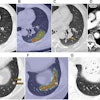Healthcare providers aren't communicating adequately with patients regarding colorectal cancer screening, even though such discussions would improve screening rates, according to a new meta-analysis published in the April 13 issue of the Annals of Internal Medicine.
The analysis, which encompassed more than 100 studies conducted in the U.S. from January 1998 to September 2009, was performed by researchers from the Evidence-Based Practice Center, run jointly by research institute RTI International of Research Triangle Park, NC, and the University of North Carolina at Chapel Hill. The study was funded by the U.S. Agency for Healthcare Research and Quality (Ann Intern Med, Vol. 152:8).
The goal of the research was to analyze the factors that affect colorectal cancer (CRC) screening, as well as to investigate the circumstances that lead to overuse and underuse to ensure more appropriate CRC screening utilization.
The researchers found that self-reported rates of CRC screening from national surveys have increased from 25% in the late 1980s to 50% to 60% in 2005 to 2006 (although the authors acknowledged that these rates are probably overestimations). They found the growth to be entirely attributable to Medicare reimbursement of screening colonoscopy, which started in 2001.
Factors that led to lower CRC screening rates included high out-of-pocket costs, lack of health insurance, and limited access to care. Hispanics, Asians, and people born outside the U.S. also had lower rates.
Factors that led to higher screening rates included having insurance and regular access to healthcare, having a physician recommend screening, and participating in other regular cancer screenings. Other important factors included being a non-Hispanic white, having a higher education level, having higher household income, and having a family history of colorectal cancer or a personal history of another type of cancer.
The researchers found that a number of strategies could increase the likelihood of appropriate utilization of CRC screening, one of which was the use of one-on-one interactions between patients and healthcare personnel such as nurses or health educators. Eliminating structural barriers to screening also had a powerful effect.
The authors concluded by stating that "important problems exist in the underuse, overuse, and misuse of CRC screening." A major weak point is that health professionals aren't talking adequately and in enough detail with patients about colorectal cancer screening, even though national guidelines recommend these discussions.
They also noted that while much of the research they analyzed focused on increased use of CRC screening, little research has concentrated on improving discussions about the technology or reducing overuse and misuse of the tests.
By Brian Casey
AuntMinnie.com staff writer
April 13, 2010
Related Reading
Hispanics have less access to colon screening, April 12, 2010
Small polyps detected at CTC screening unlikely to be dysplastic or malignant, April 6, 2010
Cancer deaths drop as colonoscopy rates soar, April 2, 2010
Massive VC study yields trove of extracolonic cancers, March 23, 2010
VC obviates need for colonoscopy even in symptomatic patients, February 24, 2010
Copyright © 2010 AuntMinnie.com




















